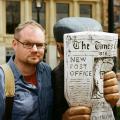A NEW map including Clydebank women accused of being witches has been published.
University of Edinburgh data experts put together the map based on research that found 3,837 people accused of witchcraft in Scotland in the 16th and 17th centuries.
They used the Survey of Scottish Witchcraft database over three months this summer to allow the public to learn more about the dark period in history.
Although popular in TV and film, thousands of mostly women were targeted by witch hunts across Europe, many of them killed.
There is substantial information missing from the three cases in what is today Clydebank.
Issobell Laing was a resident of Duntaglennie - now Duntiglennan Fields, which are subject of repeated and much disputed planning applications.
With a name spelt Layng in another record, Issobell was investigated on July 1, 1677. Information is sparse on the case other than the five male commissioners at a trial in Dumbarton.
A pre-trial note says, only: “Commission for trial issued although suspect already imprisoned. To be conducted without any torture.”
Read more: Investigation into pensioner’s ‘broken and cracked’ roofing job ongoing
The same line was used for the trial of Margaret Paterson of Duntocher, who lived in land now between Cochno Road and Loch Humphrey Burn.
A third woman jailed was Jonet Mun, of Lawmuir - now Lawmuir Farm near Faifley - who was investigated the same day.
Neighbouring Dumbarton has 16 cases, including one man and at least one who was put to death.
Hundreds of people were put on trial nationwide in five witch hunts across Scotland between 1590 and 1662.
Intern Emma Carroll worked to plot the locations on the map over the summer together with Ewan McAndrew, Wikimedian in Residence at the University of Edinburgh.
Mr McAndrew told the Scotsman: “It took quite a lot of detective work to create this map as a lot of these places don’t exist anymore.
“The map is a really effective way to connect where we are now to these stories of the past.
“There is a very strong feeling out there that not enough has been done to inform people about the women who were accused of being witches in Scotland There is still this Halloween concept surrounding them.
“The tragedy is that Scotland had five times the number of executions of women. The idea of being able to plot these on a map really brings it home. These places are near everyone.
“There does seem to be a growing movement that we need to be remembering these women, remembering what happened and understanding what happened.”
Visit witches.is.ed.ac.uk to explore the map.








Comments: Our rules
We want our comments to be a lively and valuable part of our community - a place where readers can debate and engage with the most important local issues. The ability to comment on our stories is a privilege, not a right, however, and that privilege may be withdrawn if it is abused or misused.
Please report any comments that break our rules.
Read the rules here